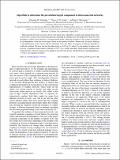Algorithm to determine the percolation largest component in interconnected networks
Author(s)
Herrmann, Hans J.; Schneider, Christian Michael; Araujo, Nuno
DownloadSchneider-2013-Algorithm to determine.pdf (756.6Kb)
PUBLISHER_POLICY
Publisher Policy
Article is made available in accordance with the publisher's policy and may be subject to US copyright law. Please refer to the publisher's site for terms of use.
Terms of use
Metadata
Show full item recordAbstract
Interconnected networks have been shown to be much more vulnerable to random and targeted failures than isolated ones, raising several interesting questions regarding the identification and mitigation of their risk. The paradigm to address these questions is the percolation model, where the resilience of the system is quantified by the dependence of the size of the largest cluster on the number of failures. Numerically, the major challenge is the identification of this cluster and the calculation of its size. Here, we propose an efficient algorithm to tackle this problem. We show that the algorithm scales as O(N log N), where N is the number of nodes in the network, a significant improvement compared to O(N[superscript 2]) for a greedy algorithm, which permits studying much larger networks. Our new strategy can be applied to any network topology and distribution of interdependencies, as well as any sequence of failures.
Date issued
2013-04Department
Massachusetts Institute of Technology. Department of Civil and Environmental EngineeringJournal
Physical Review E
Publisher
American Physical Society
Citation
Schneider, Christian, Nuno Araujo, and Hans Herrmann. “Algorithm to Determine the Percolation Largest Component in Interconnected Networks.” Phys. Rev. E 87, no. 4 (April 2013). © 2013 American Physical Society
Version: Final published version
ISSN
1539-3755
1550-2376